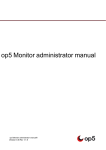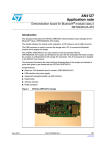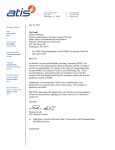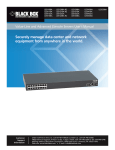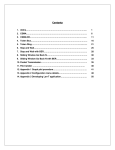Download NETWORK MONITORING USING NAGIOS AND
Transcript
NETWORK MONITORING USING NAGIOS AND AUTOCONFIGURATION FOR CYBER DEFENSE COMPETITIONS Jaipaul Vasireddy B.Tech, A.I.E.T, Jawaharlal Nehru Technological University, India, 2006 PROJECT Submitted in partial satisfaction of the requirements for the degree of MASTER OF SCIENCE in COMPUTER SCIENCE at CALIFORNIA STATE UNIVERSITY, SACRAMENTO FALL 2009 NETWORK MONITORING USING NAGIOS AND AUTOCONFIGURATION FOR CYBER DEFENSE COMPETITIONS A Project by Jaipaul Vasireddy Approved by: __________________________________, Committee Chair Dr. Isaac Ghansah __________________________________, Second Reader Prof. Richard Smith __________________________ Date ii Student: Jaipaul Vasireddy I certify that this student has met the requirements for format contained in the University format manual, and that this Project is suitable for shelving in the Library and credit is to be awarded for the Project. __________________________, Graduate Coordinator Dr. Cui Zhang Department of Computer Science iii ________________ Date Abstract of NETWORK MONITORING USING NAGIOS AND AUTOCONFIGURATION FOR CYBER DEFENSE COMPETITIONS by Jaipaul Vasireddy The goal of the project is to monitor the services running on the CCDC (College Cyber Defense Competition) network, using Nagios which uses plugins to monitor the services running on a network. Nagios is configured by building configuration files for each machine which is usually done to monitor small number of systems. The configuration of Nagios can also be automated by using shell scripting which is generally done in an industry, where the numbers of systems to be monitored are large. Both the above methods of configuration have been implemented in this project. The project has been successfully used to know the status of each service running on the defending team’s network. The project also includes network traffic reduction using failover monitoring where one Nagios machine monitors another Nagios machine so that if one machine fails the other machine does the work of the broken system. _______________________, Committee Chair Dr. Isaac Ghansah _______________________ Date iv ACKNOWLEDGEMENTS I consider this as a wonderful opportunity to thank Dr.Isaac Ghansah and Professor Smith who gave me this opportunity to work under their esteemed guidance. I also thank all the members in white team for their valuable suggestions which helped a lot for the successful completion of this project. v TABLE OF CONTENTS Page Acknowledgements……………………………………………………………………..v List of Figures…………………………………………………………………………viii Chapter 1. INTRODUCTION ………………….……………………………………………..1 2. NAGIOS…………………………………………………………………………...7 2.1 Directory Structure of Nagios……………………………………………….8 2.2 Scheduling Nagios………………………………………………………….10 3. ACTIVE MONITORING……………………………………………………… ..12 4. PASSIVE MONITORING……………………………………………………….14 4.1 NRPE Implementation Steps……………………………………………….15 4.2 NSClient++ Implementation Steps………………………………………...19 5. DISTRIBUTED MONITORING………………………………………………...21 5.1 Distributed Scoring System…………………………………………………...22 6. FAILOVER MONITORING……………………………………………………. 24 6.1 Failover Monitoring Implementation Steps…………………………………..26 7. CONFIGURING NAGIOS………………………………………………………29 8. AUTOCONFIGURATION……………………………………………………...37 8.1 Autoconfiguration Using TCP/IP Handshake………………………………..37 8.2 Autoconfiguration for Stringent Service Checks…………………………….52 vi 9. BUILDING PLUGINS……………………………………………………………54 9.1 Steps to Monitor Mysql Database…………………………………………....54 10. INJECT AUTOMATION………………………………………………………..60 11. CONCLUSION………………………………………………………………….65 Appendix A. ACRONYMS ………………………………………………………...67 Appendix B. USER MANUAL……………………………………………………...68 Appendix C. SOURCE CODE………………………………………………………71 Bibliography…………………………………………………………………………...100 vii LIST OF FIGURES Page 1. Figure 1.1 CCDC Network Design ………………………………………. .....2 2. Figure 1.2 Blue Team Network …………………………………………….....3 3. Figure 2.1 Nagios Directory Structure ……………………………………. ....8 4. Figure 3.1 Nagios Active Monitoring Overview …………………………….12 5. Figure 4.1 Overview of Nagios Passive Monitoring Using NRPE…………...15 6. Figure 4.2 Remote Linux Machine Monitoring……………………………….17 7. Figure 4.3 Overview of Nagios Passive Monitoring Using NSClient++……..18 8. Figure 4.4 Remote Windows Machine Monitoring Using NSClient++……….20 9. Figure 5.1 Distributed Monitoring……………………………………………..21 10. Figure 5.2 Distributed Scoring System………………………………………..23 11. Figure 6.1 Single Master, Multiple Slave Failover Monitoring…………….....25 12. Figure 8.1 Nagios Login Page…………………………………………………39 13. Figure 8.2 Local Host 127.0.0.1………………………………………………41 14. Figure 8.3 Third Stage of Autoconfiguration ………………………………...47 15. Figure 8.4 Host Groups ……………………………………………………….50 16. Figure 8.5 Sequence of Steps for Autoconfiguration………………………….51 17. Figure 8.6 Sequence of Steps for Autoconfiguration to Do Stringent Service Checks…………………………………………………………………………53 18. Figure 9.1 Database Monitoring Using check_db Plugin……………………...59 19. Figure 10.1 Functionality of Inject Automation Script………………………….. 61 viii 1 Chapter 1 INTRODUCTION An organization’s network infrastructure consists of routers, switches, servers and other equipment that provide services to their clients. Each day results in new security threats, including DOS (denial of service) attacks, worm and virus outbreaks deliberately created to directly or indirectly disrupt the services that our network infrastructure attempts to provide [1]. Therefore there is a necessity to understand how to protect our infrastructure by using security tools and best practices to protect each system in our network. The computer science classes csc254, csc154 (Network Security and Cryptography, Computer System Attacks and Counter Measures) educates students with theoretical knowledge necessary to protect the network infrastructure, students can apply the security practices learned in class on the CCDC network, depicted in Figure1.1 taken from[2]. And in order to understand how a hacker thinks there should be someone who needs to attack the CCDC network, so the entire class is divided into two groups where one group attacks the CCDC network called the Red team (attackers) and other group defends the network called the Blue team (defenders). But there should be a way where the performance of the teams can be known, this project provides a way where performance of the teams can be known. The project is to build a monitoring system using Nagios for the college cyber defense competition where there are two teams which are called Red team (attackers), 2 and Blue team (defenders). Each team is assigned a group of systems on which they have been given administrative privileges, and they are placed in separate rooms so that each team has privacy. Figure 1.1: CCDC Network Design [2] 3 The goal of the attackers is to bring down the services of the defenders, and the job of the defending team is to defend themselves from being hacked and always keep their services running. The monitoring tool Nagios is used to check the services running on the blue teams network (Figure 1.2 taken from [2]) periodically, and store the collected data in MySQL database which is further utilized for scoring purposes to determine the performance of each team [3]. Figure1.2: Blue Team Network [2]. 4 Apart from the blue team and red team there is a third team called the white team who are the judges of the competition. The job of the white team is to set up the network for the competition and to frame rules for the competition before the competition begins so that the competition is played fair. They also create a real time industry environment so that students would have better exposure. They do this by sending injects, which are something like a work order which are further discussed in the report. There are eight regional CCDC competitions which are held in United States, the Western Regional Collegiate Cyber Defense Competition held at Cal Poly (California State Polytechnic University, Pomona) is one such regional competition. Sacramento State University sends a team, who are cognizant in network security to Cal Poly every year. The winners of each regional competition compete in National Collegiate Cyber Defense Competition held at University of Texas, San Antonio, where scoring is done on a positive scale, and the team with the highest number of points wins the competition unlike ours where scoring is done on a negative scale and defending teams start at zero points and the team which has lower points wins the competition. The other major difference is performance can be known only at the end of the day because the scoring is done by maintaining logs for each service being monitored [4]. Unlike ours, where we can know the performance of the team, any time during the competition. 5 The CCDC is similar to capture the flag contest which is held at Defcon the hacker’s conference at Las Vegas, Nevada. In capture the flag contest, the participating teams have a dedicated flag for each service and they need to keep their services running while attempting to change the flags of competitor’s services to their own. Their scoring system is designed in such a way that it periodically checks the functionality of each of the competitor’s network. If the service is functional, and the flag is that of the owning team, the team receives points. If the service is unavailable the team receives no points. If the service is running but the flag is of another team, the other team gets the points [5]. The report is further organized as follows. Chapter2: Nagios; The functionality and directory structure of Nagios is discussed. Chapter3: Active monitoring; In Active monitoring Nagios directly checks the status of each service. Chapter4: Passive monitoring; In Passive Monitoring Nagios uses plug-ins to run remotely which report their results to Nagios. Chapter5: Distributed monitoring; In Distributed monitoring the network infrastructure is monitored by different monitoring machines. Chapter6: Failover monitoring; In Failover monitoring one Nagios machine monitors another Nagios machine, the sequence of steps which needs to be followed are discussed here. Chapter7: Configuration of Nagios; Here the sequence of steps to be followed to configure Nagios are discussed. 6 Chapter8: Autoconfiguration; Here the purpose of Autoconfiguration, the format of text files which needs to be written for proper functionality of Autoconfiguration scripts is discussed. Chapter9: Inject automation; a shell script which is used to send injects for the defending team is explained. Chapter 10: Conclusion; Here the strengths and weaknesses of the project are discussed. 7 Chapter 2 NAGIOS Nagios is a monitoring tool that monitors current status of hosts, printers, switches and services that run on a network. The CCDC network is monitored using Nagios. Nagios compilation requires gcc, make, autoconf, and automake utilities. The required libraries for Nagios compilation are libgd and openssl [6]. Nagios plugins are used to monitor services running on each host on a specified port with a specified IP. Nagios allows notifications to be sent through email when a particular service or host is down to the network administrator. Nagios can monitor the publicly available services in two ways active monitoring and passive monitoring. In active monitoring Nagios directly monitors the services of the host, where as in passive monitoring an add-on running on the remote host reports its results to Nagios. Using passive monitoring you can also monitor private information of the remote machine such as number of processes which otherwise cannot be accessed using active monitoring. Nagios can be scheduled to monitor in a 24*7 environment or it can be scheduled to monitor in specific time interval like nine to five. It can also be scheduled to monitor in a 24*7 environment except on holidays. The entire configuration of Nagios depends on three configuration files nagios.cfg, cgi.cfg and resource.cfg. Nagios considers each network component to be monitored as an object, and all object definitions end up in the subdirectory called objects [1]. 8 2.1 Directory Structure of Nagios The directory structure of nagios is depicted in Figure 2.1 ---nagios.cfg ---cgi.cfg ---resource.cfg ---Objects----templates.cfg ----commands.cfg ----contacts.cfg ----timeperiods.cfg ----localhost.cfg ----windows.cfg ----printer.cfg ----switch.cfg Figure 2.1 Nagios Directory Structure A Few of the Significant Configuration Options of nagios.cfg are explained below. Accept_passive_host_checks: If agents like Nrpe or Nsclient are to be disabled this option needs to be zero by default it is set as one. Admin_email: The email address of the Nagios administrator specified in macro $ADM INEMAIL$, all the notifications will be send to this particular email address. This was specified as [email protected]. Log_file: All errors and problems are recorded in this file. 9 Log_passive_checks: Specifies whether Nagios should log passive checks in the log file (1=enable, 0=disable). Enable_notifications: Specifies whether Nagios can send notifications (1=enable, 0=disable). It was set as 1 so that all the notifications will be sent to [email protected]. Enable_environment_macros: Specifies macros like $HOSTADDRESS$ can be accessed as environment variables (1=enable, 0=disable). It was set as 1. Log_rotation_method: Specifies the time after which the log file is considered stale and a new file is created the different options are n for don’t rotate the log, h for hourly log rotation ,d for daily rotation ,w for weekly rotation for monthly rotation. We specified the log rotation to be none. The significant configuration options specified in templates.cfg are discussed below. Check_period: The time during which the service check can be done, was specified as 24*7 since the competition is run in a 24*7 environment, the defending teams services needs to be checked all throughout the day. Max_check_attempts: Nagios does not report a state until a certain number of attempts specified by the user, it was configured as three so that it needs to check thrice before reporting a state. Retry_check_interval: It specifies the time gap between two attempts to determine a hard state, it was specified as one. 10 Normal_check_interval: Specifies the time gap between successive checks during normal conditions, i.e. if nagios determines a hard state in the first attempt the next attempt will be after 5 minutes. 2.2 Scheduling Nagios Although the competition is run in a 24*7 environment there is always a possibility of having a holiday during the competition. In such cases instead of manually stopping and starting nagios, we can directly specify the time during which nagios needs to monitor, in a file called timeperiods.cfg .Here we define a time period and make sure that the templates.cfg file uses the defined time period. The configuration option in templates.cfg is check_period, which in turn is used by all object configuration files. For example if Nagios needs to be running in a 24*7 environment except on memorial day, we create a holiday time template which in turn is used by CCDC-working timeperiod, so that when we use the CCDC-working time period in the template definition, the services will not be checked on the specified days. Define timeperiod { Timeperiod_name ccdc-holidays Monday -1 may } 00:00-00:00 11 And we defined a second template called ccdc-working Define timeperiod { Timeperiod_name ccdc-working Use ccdc-holidays Sunday 00:00-24:00 Monday 00:00-24:00 Tuesday 00:00-24:00 Wednesday 00:00-24:00 Thursday 00:00-24:00 Friday00:00-24:00 Saturday00:00-24:00 } Apart from network monitoring, Nagios can be used to analyze numerical data like temperature, which is retrieved from different sensors and compares it with the preconfigured temperature, and if needed, sends an alert to the system administrator. 12 Chapter 3 ACTIVE MONITORING Active monitoring is a way in which Nagios directly monitors the services of each machine by using plugins. Nagios uses check logic, which in turn uses plugins when it needs to monitor a host or service. A plugin can be shell script or Perl script (Nagios has an embedded Perl interpreter) that runs from the command line to perform a host or service check and then returns their results to the Nagios daemon. This further performs the required action like sending notifications. The frequency at which these checks should be done is specified in check_interval and retry_interval of the host and service definitions. Figure 3.1 Nagios Active Monitoring Overview (source:www.Nagios.org) 13 If the plugin finds a hard state like ok or critical, the next scheduled check will be the check_interval. If the service is flapping, that is, if it’s not sure if the service is ok or critical, and it’s still under the maximum allowed check_attempts, the next scheduled check is the retry_interval. Example of active check: check_tcp –H 192.168.129.17 -w 5 –c 10 This means that the machine 192.168.129.17 needs to complete the handshake within 5 seconds, otherwise it’s going to report a warning and if it does not respond within 10 seconds it’s going to report a critical stage. 14 Chapter 4 PASSIVE MONITORING A logical question could be: when there is active monitoring what’s the need for passive monitoring? With active monitoring one can just check the services running on the machine, but you cannot retrieve the private information of the machine, such as number of users on the machine, the load on the machine, the total number of processes on the machine. This type of data is required in an IT industry in order to make sure that systems meet their performance criteria. If not, the situation needs to be reported to the authorized individual so that he could take the necessary steps. This crucial data cannot be acquired by a simple hand shake protocol such as TCP/IP. So in order to acquire this private data, you need to have daemon running on the client side which can be installed only when you have administrative privileges on the system. Systems that need to be monitored can either be a windows system or a Linux system; depending on the operating system of the client you can either install NRPE agent if it’s a Linux system or NSClient++ agent if it’s a windows machine. And we use respective plugins check_nrpe, check_nsclient++ to retrieve the data from the agents installed remotely. In short, if you want to monitor the services running behind the firewall we use passive monitoring. The relationship between the agent, plugin, monitoring server and the monitored server in Linux environment is depicted in Figure 4.1. 15 Figure 4.1 Overview of Nagios Passive Monitoring Using NRPE (source:www.Nagios.org) 4.1 NRPE Implementation Steps [4]: Step1: Install Nrpe agent on the remote server (instructions how to install are specified in the user manual). Step2:Check_nrpe by default comes with Nagios but we still need to define in command definition. So add the following definition in /usr/local/nagios/etc/commands.cfg. define command { command_name check_nrpe command_line $USER1$/check_nrpe -H $HOSTADDRESS$ -c $ARG1$ } Step3: Test communication with the remote host by using the following command /usr/local/nagios/libexec/check_nrpe -H ip (ip address of remote host on which Nrpe is installed). 16 This should return the version of Nrpe on the remote host. If the above command does not return the version number make sure the firewall on the remote host does not block the monitoring host. Step5: Define the service which needs to be monitored on the remote host in the monitoring host. Example: define service{ use generic-service host_name remotehost service_description Swap Usage check_command check_nrpe!check_users } Step6: Define the check_users command in the nrpe.cfg file in remote host; this will cause the Nrpe Daemon to run check_users command on the remote host. command [check_users]=/usr/local/nagios/libexec/check_users -w 10 -c 20. 17 Figure 4.2 Remote Linux Machine Monitoring 18 The relationship between the agent, plugin, monitoring server and the monitored server in windows environment is depicted in Figure 4.3 Figure 4.3 Overview of Nagios Passive Monitoring Using NSClient++ (source: www.Nagios.org) 19 4.2 NSClient++ Implementation Steps [4]: Step1: Install NSClient++ agent on windows machine (steps to install the NSClient are in the user manual). Step2: Create new host and service definitions for the remote windows machine where NSClient++ is installed on the nagios machine. Step3: Specify the command definition for the service defined above at the remote host. Step4: Include the path where host and services are defined in the nagios.cfg file which is under /usr/local/nagios/etc. Step5: Save the nagios file and exit. Step6: Restart nagios with the command service nagios restart. 20 Figure 4.4 Remote Windows Machine Monitoring Using NSClient++ 21 Chapter 5 DISTRIBUTED MONITORING The reason why we need to have distributed monitoring is to reduce the network traffic. We have increased traffic because of the two Nagios machines doing the same job, that is, both the machines are monitoring the same systems. Therefore, in order to reduce the network traffic we can reduce the overhead on each machine by dividing the work between the two machines, so that a different set of machines are monitored by each server. The way it is implemented is depicted in Figure5.1; here the system Packet is monitoring systems Shannon, Turing, Seeall and the system Binary is monitoring systems Morse, Smelt, Datagram. This type of monitoring does not perfectly embed itself in our scoring requirement since we have two scoring engines each maintaining their own database. However, in an IT industry the monitoring infrastructure is never centralized, and they do not need a scoring system; in such cases distributed monitoring is done. Shannon Packet Binary (Nagios) (Nagios) Turing Seeall Figure 5.1 Distributed Monitoring Morse Smelt Datagram 22 5.1 Distributed Scoring System However, if distributed scoring needs to be developed, there is a way in which that objective can be attained, i.e. if both the monitoring systems place their monitored data in a separate database and if the scoring is done based on that databases as depicted in Figure 5.2. It’s possible to have distributed scoring system. It was observed in the competition that the defending team blocked the traffic coming from one of the scoring system and allowed the traffic from the other scoring machines, which is the reason that we have different scores from each of the machines. Because we have different sets of data for the same machines which are being monitored, we were able to figure it out, what exactly defending team has done. The problem with this distributed scoring system is that, if the defending team blocked any of the monitoring system, there is no way for the white team members to know whether the service is down because of the work done by Red team or the defending team have blocked the scoring machine. Because we just have one set of monitored data for each set of machines. 23 Scoring Scoring Database Database Packet (Nagios) Shannon Turing Binary (Nagios) Seeall Figure 5.2 Distributed Scoring System Morse Smelt Datagram 24 Chapter 6 FAILOVER MONITORING In college cyber defense competition, we have two monitoring systems doing the same job; we have done that to improve availability. But the problem is, the amount of traffic being generated on the network which might lead to network congestion. One solution to the problem is failover monitoring in which if one system fails, the other system takes the burden. In other words, we establish a master slave relation between the two systems, so that at any point of time we have only one system which monitors the defending teams. We do this by installing a remote agent called Nrpe on the master machine, and the slave keeps on checking the status of Nagios on master machine through check_nrpe plugin which talks to Nrpe on master, so that if master nagios fails, the slave nagios picks up the job of the slave. It does this by enabling the service check options in nagios.cfg file as shown below “execute service checks =0” to “execute service checks =1” and “enable notifications=0” to “enable notifications=1” It can also let someone in white team know that the system has crashed by email, or it can send a message to their cell phone. Although it picks up the job of the master, it still keeps on checking the status of master hoping that white team members would intervene. At some point of time, if the master is up because of intervention of white team members, it goes back to original state. This task is achieved by writing a shell script which checks the condition of master Nagios at regular intervals. 25 So if at any point, if master is up, the shell script disables the service check in nagios.cfg file. The configuration changes which the shell script does are shown below. “execute service checks =1” to “execute service checks =0” and “enable notifications=1” to “enable notifications=0” It’s also possible for the master two have n number of slaves, such that each monitors a different subset of machines so that if the master fails, the slaves come up. The way it can be implemented is shown in Figure 6.1. A B C D E Nagios Master Nagios Slave1 Nagios Slave2 A C B Nagios Slave 3 D Figure 6.1 Single Master, Multiple Slave Failover Monitoring. E 26 6.1 Failover Monitoring Implementation Steps: Step1: Install Nrpe agent on the master side Step2: Add a command definition in /usr/local/nagios/etc/nrpe.cfg of master command [check_nagios]= -e 1 -F /usr/local/nagios/var/status.log -C /usr/local/nagios/bin/nagios Where –e is used to indicate the time after which the file is considered stale -F is used to indicate the file which you are looking for, which is the log file -C is used to indicate the substring in the process arguments Step3: Define service check_nagios on the slave side. define service{ use generic-service host_name remotehost service_description check nagios check_command check_nrpe! check_nagios } Step4:check_nrpe plugin by default comes with Nagios but we still need to define in command definition So add the following definition in /usr/local/nagios/etc/commands.cfg define command { command_name check_nrpe command_line $USER1$/check_nrpe -H $HOSTADDRESS$ -c $ARG1$ } 27 Step5: Test communication with the master by using the following command /usr/local/nagios/libexec/check_nrpe -H ip (ip address of slave on which Nrpe is installed) This should return the version of Nrpe on the master. Step6: If the above command does not return the version number make sure the firewall on the master does not block the master Step7: Write a shell script on slave side that talks with Nrpe on the master side and either enable or disable service checks depending on the status of master. Step8: Set the shell script as a cron job by editing crontab file which is under /etc/crontab. You can edit this file by the command crontab –e and make sure the script failover.sh is being executed. 28 Shell script which does the failover monitoring #/bin/sh declare -a temp var=`/usr/local/nagios/libexec/check_nrpe -H 172.16.30.229 -c check_nagios` temp=(`echo $var | tr ':' ' '`) case ${temp[1]} in 'OK') echo nagios on PACKET is fine sed -e 's!execute_service_checks=1!execute_service_checks=0!' -e 's!enable_notifications=1!enable_notifications=0!' /usr/local/nagios/etc/nagios.cfg > /shelltest/test cp /shelltest/test /usr/local/nagios/etc/nagios.cfg service nagios restart ;; 'CRITICAL') echo nagios on PACKET is critical sed -e 's!execute_service_checks=0!execute_service_checks=1!' -e 's!enable_notifications=0!enable_notifications=1!' /usr/local/nagios/etc/nagios.cfg > /shelltest/test cp /shelltest/test /usr/local/nagios/etc/nagios.cfg service nagios restart ;;Esac 29 Chapter 7 CONFIGURING NAGIOS Nagios is configured by building configuration files for each machine that needs to be monitored. This type of configuration is used in places where there are small numbers of systems to be monitored but not in an industry environment because it takes lot of time to build configuration files for each individual machine. The disadvantage of building configuration files is that, a novice cannot configure Nagios unless he has good understanding of the tool. Steps to be followed for configuration: Step1: Identify the systems to be monitored. Step2: Identify the IPs of each machine since nagios monitoring is IP based. Step3: Identify the services running on each machine. Step4: Prepare configuration files for each machine which defines host and service definition and name each file with .cfg extension. Step5: Define command definition for each service of the configuration file in command.cfg file. Steps6: Include the path where these configuration file are present in nagios.cfg because when nagios starts it reads this file. Step7: Since there are two defender teams it’s difficult to distinguish the systems of each group so in order to identify them create two host groups. Step8: Start nagios with the command “service nagios start”. 30 Configuration of CCDC monitoring system: Step1: Identify the systems to be monitored Step2: Identify the IP address of each machine. Step3: Identify the services running on each machine. Step4: Here is how a configuration file in nagios is built say for monitoring http on a machine called Datagram. Create a file called Datagram.cfg and define the host and service definition for that machine as follows. #definition for Datagram machine define host{ use ccdc-host host_name Datagram alias address Datagram 192.168.129.117 } define service{ use ccdc-service host_name Datagram service_description DNS check_command check_dns!smelt.local!192.168.66.210 } 31 Step5: For the service defined above in step4 you need to define a command in commands.cfg which is in /usr/local/nagios/etc directory. #'check_dns’ define command{ command_name check_dns command_line $USER1$/check_dns -s $HOSTADRESS$ -H $ARG1$ -a $ARG2$ } Where -s: specifies the DNS server where the lookup needs to be done. -H: specifies the name of the machine which is being searched. -a: specifies the expected ip which the DNS server needs to return. Step6: Open the nagios.cfg file which is usually in /usr/local/nagios/etc/objects/nagios.cfg and place the path of configuration file in this file. Step7: Since there are two teams create groups which consists of machines from each team, since datagram is from say red1 declare the below definition in datagram.cfg define hostgroup{ hostgroup_name Red1; alias members } Red1; Long name of the group Datagram,Smelt,Turing,seeall; 32 The other service and command definitions to monitor each service is show below. HTTP: Service definition: define service{ use ccdc-service host_name Smelt service_description HTTP check_command check_http!”33d!”It works” } Command definition: define command{ command_name check_http command_line $USER1$/check_http –I $HOSTADDRESS$ -M $ARG1$ -s $ARG2$ } Where -I: specifies the host address -M: specifies the days after which the document is considered old. -s: specifies the string which needs to be found on the page 33 HTTPS: Service definition: define service{ use ccdc-service host_name Michael service_description HTTPS check_command check_https!443!http://192.168.194.210/index.php } Command definition: define command{ command_name check_http command_line $USER1$/check_http –I $HOSTADDRESS$ -p $ARG1$ -S -u $ARG2$ } Where -I: specifies the host address. -p: specifies the port number. -S: specifies SSL connection. -u: specifies the URL. SMTP: 34 Service definition: define service{ use ccdc-service host_name Dwight service_description check_command SMTP check_smtp!HELO from white!”tech- com.cyberdyne.local”!5!10 } Command definition define command{ command_name check_smtp command_line $USER1$/check_http –H $HOSTADDRESS$ -C $ARG1$ -R $ARG2$ -w $ARG3$ -c $ARG4$ } Where: -H: specifies the host address. -C: specifies the command which needs to be executed at the remote server. -R: specifies the response which is expected for the command which is specified by option –C. -w: specifies time after a warning should be given. -c: specifies time after which a critical message should be given. 35 POP: Service definition: define service{ use ccdc-service host_name Dwight service_description pop check_command check_pop!110!Dovecot } Command definition: define command{ command_name check_pop command_line $USER1$/check_pop –H $HOSTADDRESS$ -p $ARG1$ -e $ARG2$ } Where: -H: specifies the host address. -p: specifies the port number. -e: specifies the expected string in the response. Security is another major strength of Nagios which uses SSH protocol, which sends monitoring data in encrypted format across the network. Here is an example of how SSH can be used to monitor SMTP (simple mail transfer protocol) status using SSH. The 36 service SMTP needs to be defined in the configuration file of the machine which needs to be monitored. define service{ use ccdc-service host_name Fiber service_description smtp check_command check_smtp } For the above service the command definition needs to be declared in the command.cfg file in the below way using check_by_ssh plug-in. define command{ command_name check_smtp command_line $USER1$/check_by_ssh -H $HOSTADDRESS$ -C check_smtp } 37 Chapter 8 AUTOCONFIGURATION The Reason why we have Autoconfiguration is because the earlier discussed configuration in chapter seven is not practical in an IT industry when there are hundreds of systems to be monitored, as it takes lot of time to build configuration files for each system. Instead of that, we can have a text file in particular format, which specifies the machine name, the machines IP and the services to be monitored. We can have a shell script, which takes text file as a feed and generates configuration files depending on the text file and keeps the generated file paths in nagios main configuration file so that when Nagios starts, it starts looking for these machines based on their IP and consequently checks for their services on the particular port. 8.1 Autoconfiguration Using TCP/IP Handshake Here are the steps for Autoconfiguration which configures Nagios, so that Nagios uses TCP/IP handshake to know the service is running or not. Steps for Autoconfiguration to do stringent service checks are specified in later part of this chapter. Stage1: A shell script which installs nagios. The user needs to be sure that “yum”package installed on the system .Once the user is sure he has “yum”installed, the user needs to copy the folder called CCDC from the flash drive under root, and the user needs to be in ccdc directory before he runs the script. Then run the script called nagios-installation.sh so that it’s going to install the necessary packages required for Nagios, which are glibc-common, gcc, and gd-devel. 38 During the installation the system asks the user for an email to whom notifications need to be sent, this generally refers to the Nagios administrators email. The script is written in such a way that if any module installation fails, the script will no longer continue to execute and it comes out of the installation. At the same time the script generates a log file called nagiosinstallation.log and any errors in the installation can be verified by viewing this log file. In the CCDC competition when we have a 24*7 environment we don’t have any problems with it, but when we have a holiday in the middle of the competition, and if we have Nagios running, it’s going to affect the scoring system calculating points even when not required. So instead of manually stopping and starting Nagios, you can schedule it to start and stop before the competition begins by modifying the time templates.cfg file in objects folder of Nagios. All you have to do is to make sure that us-holidays definition has the holidays declared for example say November 11th. And there is one more definition called 24*7_sans_ holidays which uses us-holidays definition, the main objective of this time period definition is to work on the scheduled time periods except for the scheduled downtime in us-holidays definition. Then you need to make sure the service definition and host definition and contact information definition uses the 24x7_sans_holidays. After Stage 1 you have the local host configured to be monitored by Nagios. If you start Nagios with the command “service nagios start,” and if open your browser with the address http://localhost/nagios, you can see the following page shown in Figure 8.1 where 39 you are supposed to enter the Nagios admin password which you entered during installation in Stage1. Fi Figure 8.1 Nagios Login Page 40 Nagios by default configures the local host with 127.0.0.1 which is the loop back address of the machine on which Nagios is installed, this can be seen in Figure 8.2. 41 Figure 8.2 Local Host 127.0.0.1 42 At this point you can even open the email which you specified in stage 1 and see the notifications. Stage2: The second script is the nagios-config-files.sh script: This main functionality of this script can be described in two stages. Stage2.1: Script generates ccdc host, ccdc service, and contact templates and places them in templates.cfg file which are later used by host and service definition. The parameters which are configured in the templates are as follows. Active_checks_enabled: Setting this to 1 allows Nagios directly to monitor service on the remote machine. This was specified as 1. Passive_checks_enabled: Setting this to 1 allows Nagios to get service data from a remote machine such as Nrpe. This was specified as 1. Contact_groups: This is by default is specified as admins and the email address specified by the user during installation in stage 1 refers to this particular contact. Notifications_enabled: Allows Nagios to send notifications to the email specified during stage1. This was specified as 1. Notification_options: It depends on nagios administrators requirement whether he want to be notified for only critical messages then it should be specified as ‘c’ if he wants to be notified for warning it should be specified as ‘w’, if he wants to be notified for unknown states then it should be declared as ‘u’.if he wants to be notified for all the states then it should be specified as ‘w, c, u’. 43 Notification interval: This specifies the time gap between two notifications. This was specified as 60, so notifications will be sent for every hour. Notification period: This refers to the time template during which he likes to receive notifications. This was specified as 24*7, so that notifications could be sent during any time of the day. Service_notification_commands: & Host_notification_commands: This specifies the way in which the notification needs to be sent since we are using email We specify this by the command ‘notify-service-by-email’. Max_check_attempts: This specifies the maximum number of times nagios should check for a service or host state to confirm a state. This was specified as 3 attempts. Normal_check_interval: This specifies the time interval between two attempts, to be clear if it finds a hard state like ‘ok’ or critical in the first attempt, the time gap for the next check is specified by this option. This was specified as 5 minutes. Retry_check_interval: If nagios finds the service is unknown then this particular option specifies when the next check should be done instead of normal_check_interval. This was specified as 1 minute. Stage2.2: Script defines host and services of each machine that needs to be monitored and nagios-config-text serves as input for this script, so before the user runs this script he needs to make sure that nagios-config-text is written. Here is how nagios-config-text needs to be written 44 Machine ip, machine name, service 1, service 2, service 3 Example: 192.168.129.117, Datagram, http, rdp, dns 192.168.130.112, Shannon, smtp, pop, mysql Once this text file is written run the configuration script (nagios-config-files.sh): Example of Configuration text 192.168.130.114,Fiber,dns,rdp 192.168.130.117,Firewire,dns,http,rdp 192.168.130.110, Morse, https So for example for the first line it creates a file called Fiber.cfg in usr/local/nagios/etc/objects with the following content define host{ use ccdc-host host_name Fiber alias address Uses ccdc-host template which is in templates.cfg created by stage 2.1 Fiber 192.168.130.114 } define service{ use ccdc-service host_name Fiber service_description dns check_command check_dns Uses ccdc-service template which is in templates.cfg created by stage 2.1 45 } And in the same way it generates configuration files for each machine depending on number of hosts in the text file. Stage3: A shell script (nagios-commands.sh) which defines command definition (commands trigger TCP check with each port) for each service defined in stage 2 based on the input from a text file called nagios-commands-text. The file nagios-commands-text should be written in the following format before executing the shell script, machine IP, machine name, service being checked, port number of the service being checked. Once this text file is written, run the script called nagios-commands.sh. Example of command_text: 192.168.130.114, Fiber, dns, 53, rdp, 3389 192.168.130.117, Firewire, dns, 53, rdp, 3389 192.168.130.110, Morse, secht, 443, http, 80 192.168.129.117, Datagram, rdp, 3389, dns, 53 So for example for the first line it generates the following command definition in /usr/local/nagios/etc/objects/commands.cfg #check_dns using TCP define command{ command_name check_dns' 46 command_line $USER1$/check_tcp -H $HOSTADDRESS$ -p 53 } #check_rdp using TCP define command{ command_name check_rdp' command_line $USER1$/check_tcp -H $HOSTADDRESS$ -p 3389 } Once the above command definitions are generated if you restart Nagios and open your browser with http://localhost/nagios you can see all the changes you made in the GUI. The different hosts along with their services can be seen in Figure 8.3. 47 Figure 8.3 Third Stage of Autoconfiguration. 48 Stage4: In the competition, since there are two groups, it is difficult to distinguish the groups from a single snap shot of Nagios, but Nagios allows creating host groups so that each group can be distinguished. So declare host groups definition on any one machine from each group; this host group declaration is also automated in the project all that user needs to do is write a text file called hostgroup_text in the following format, group name, machine1,machine2 each separated by comma, the second group beginning from the next line. Once this script is written run the script called hostgroup.sh. Example of hostgroup_text: Red1, Morse, Binary Red2, Shannon, Smelt, Packet, Datagram So for example for the first line it generates the following definition in morse.cfg file which is under /usr/local/nagios/etc/objects define hostgroup{ hostgroup_name Red1 alias Red1 ; Long name of the group members Morse,Binary; } 49 So for the next line it creates the below hostgroup definition in Shannon.cfg define hostgroup{ hostgroup_name Red2 alias Red2 ; Long name of the group members Shannon, Smelt, Packet, Datagram; } So once the above definition is defined, if you restart nagios and click on the hostgroup summary radio button, you can see the host and status information of each group in two different columns as seen in Figure 8.4. 50 Figure 8.4 Host Groups 51 Stage5: Do a preflight check by running script called preflight.sh. To just check things are fine if there are errors check you nagios configuration. The order of the scripts which needs to be executed for Autoconfiguration is shown in the Figure 8.5 Nagios-installation.sh Nagios-config-files.sh Nagios-config-text Nagios- Commands.sh Nagios-commandtext : Hostgroup.sh Hostgroup-text Chapoter 10 Preflight.sh Inject automation Figure 8.5 Sequence of Steps for Autoconfiguration. 52 8.2 Autoconfiguration for Stringent Service Checks: Sometimes a TCP/IP handshake is just not sufficient to know the functionality of a service on a remote machine, in such cases we check each service in a stringent way. The different steps to be followed are specified below and they are also shown in Figure 8.6 Step1: Execute Nagios-installation.sh script Step2: Make sure nagios-config-text file is written in the following format ip, machine name, and list of services separated by comma. Example: 192.168.130.114, Fiber, dns, rdp Step3: Execute nagios-config-gen.sh script which expects input from the user, and it then defines each service according to the input given by the user. Step4: Execute nagios-commands-gen.sh script which defines the commands in commands.cfg file for the services specified in nagios-config-text file. Step5: Make sure hostgroup-text file is written in the following format, Group name, and list of members separated by commas. Example: Red2, Shannon, Smelt, Packet, Datagram Step6: Execute hostgroup.sh script which generates host group definition. Step7: Execute preflight.sh script to check whether there are errors in the configuration. Step8: Start the service with the command service nagios start. 53 Nagios-installation.sh Nagios-config-gen.sh Nagios-config-text Nagios-commands-gen.sh Hostgroup.sh Hostgroup-text Preflight.sh Figure 8.6 Sequence of Steps for Autoconfiguration to Do Stringent Service Checks. 54 Chapter 9 BUILDING PLUGINS Before we write plugins, we need to understand what a plugin is? A plugin is a piece of code, either written in Shell or Perl. Nagios already has inbuilt plugins but there is always a requirement that’s one requirement is not met with the plugins that comes with Nagios. For example the plugins which come with nagios to monitor Mysql database are check_mysql and check_mysql_query, cannot insert a row or delete a row in the database, to know the status of the database such actions needs to be done. In such cases we write our own scripts, and configure Nagios so that Nagios is going to poll the script, and uses the results reported by the script to determine the status of service. Here is a plugin which monitors the status of Mysql database by inserting a row and then selecting it, there after deleting the row earlier inserted and then selecting the rows in a table called student in test database. 9.1 Steps to Monitor Mysql Database Step1: login as root user in the local Mysql database called test. Step2: Create a table called student with just one row and one column called “id” in database test. Step3: Create a user called “me” with password called “pass”. Step4: grant select, insert, delete operation privileges on this table for this user called “me” with the command. 55 GRANT select, insert, delete ON test.student TO me; Step5: Write a shell script which inserts a row, and selects it, deletes a row which got inserted earlier and then selects it. The plugin check_db uses a header called jutils.sh where the states are defined. Below is the jutils.sh script #! /bin/sh STATE_OK=0 STATE_WARNING=1 STATE_CRITICAL=2 STATE_UNKNOWN=3 if test -x /usr/bin/printf; then ECHO=/usr/bin/printf else ECHO=echo fi print_revision() { echo "$1 v$2 " $ECHO "The nagios plugins come with ABSOLUTELY NO WARRANTY. You may redistribute\ncopies of the plugins under the terms of the GNU General Public License.\n For more information about these matters, see the file named COPYING.\n" | sed -e 's/\n/ /g' } support() { $ECHO "Send email to [email protected] if you have questions\n regarding use of this plugin. " | sed -e 's/\n/ /g' } 56 Here is the check_db plugin which inserts a row, selects it, deletes a row and then selects it. #!/bin/sh PROGNAME=`/bin/basename $0` PROGPATH=`echo $0 | sed -e 's,[\\/][^\\/][^\\/]*$,,'` . $PROGPATH/jutils.sh print_usage() { echo "Usage: $PROGNAME -H hostname" echo "Usage: $PROGNAME --help" } print_help() { print_usage echo "" echo "Inserts a row selects it, deletes a row and selects it from a table called dbmonitor inside database test" echo "" support } # Make sure the correct number of command line # arguments have been supplied if you want to monitor remote database #if [ $# -lt 1 ]; then # print_usage # exit $STATE_UNKNOWN #fi # Get the command line arguments #host=$2 #echo $host ## If the host name doesn't exist, exit # #if [ ! -e $host ]; then # $echo " could not find host ip!\n" # exit $STATE_UNKNOWN IRESULT=`/usr/bin/mysql --user=me --password=pass <<SQL use test insert into dbmonitor values (1); 57 select * from dbmonitor; quit SQL` case "$IRESULT" in *1) IRESULT=1; ;; esac DRESULT=`/usr/bin/mysql --user=me --password=pass <<SQL use test delete from dbmonitor where id=1; select * from dbmonitor; quit SQL` LEN=$(echo ${#DRESULT}) if [ $LEN -eq 0 ];then DRESULT=0; fi exitstatus=$STATE_WARNING #default if [ $IRESULT -eq 1 ];then if [ $DRESULT -eq 0 ];then echo check_db:OK INSERT AND DELETE SUCCEFULL exit $STATE_OK else echo check_db:CRITICAL INSERT SUCCESSFULL BUT DELETE FAILURE exit $STATE_CRITICAL fi else echo check_db:CRITICAL INSERT FAILURE exit $STATE_CRITICAL fi exit $exitstatus 58 Step6: We integrate the plugin into nagios by defining a service in the configuration file of the local machine, and defining a command in the command definition in localhost.cfg define service{ use local-service host_name localhost service_description DBcheck check_command check_db } We specify the exact path where the script is located in command.cfg. define command{ command_name check_db command_line /ccdc_nagios/nagios-plugins-1.4.13/plugins-scripts/check_db } Step7: Restart Nagios with the command “service nagios restart”. Hers is a screenshot of database monitoring on local host in Figure 9.1. 59 Figure 9.1 Database Monitoring Using check_db Plugin. 60 Chapter 10 INJECT AUTOMATION In the beginning of the competition, we have someone among the white team, who is sending injects for the defending team at a particular point of time. The white team members need to go to the machine, to check whether the job has been done or not. In order to reduce the burden on the white team, even these injects can be automated by using shell scripting. Here we build a text file specifying the name of the day, month, the time at which the inject needs to be send, the time from which Nagios starts looking for that particular service, the machine name on which the service needs to be checked, the name of the service and the port number on which Nagios starts checking for a hand shake. We have a shell script which is being executed as a cron job which takes this text file as input and processes the date command and looks for a matching date and time in the text file. If it matches the date and time in the text file, it immediately sends an email to the entire defending team saying that a service needs to be installed at particular port. If time matches the Nagios checking time, it immediately changes the configuration file of that machine on which the service needs to be installed and restarts Nagios so that changes are going to take effect and Nagios starts looking for this new service. The functionality of the inject automation script is depicted in Figure 9.1. 61 Text file Shell script Found a match with inject .initiation Set as Cron job which reads the text file Found a match with Nagios date Change machine configuration file Send email to defending team Restart nagios Figure 10.1 Functionality of Inject Automation Script 62 Here is the shell script which reads a text file #/bin/sh #the text file which this shell script should read should be in the following format example Mon Dec 15 19:42:47 PST 2008 19:53:00 Fiber mysql 53 #where 19:42:47 is the time when the email will be sent to the blue team #regarding the inject and at 19:53:00 it automatically configures nagios for #monitoring declare -a b d var=`date` temp=(`echo $var | tr ',' ' '`) a=${temp[3]} echo $a while read line ;do auto=(`echo $line | tr ',' ' '`) b=${auto[3]} c=${auto[6]} if [ $temp[1] == $auto[1] ] && [ $temp[2] == $auto[2] ] && [ $temp[5] == $auto[5] ] && [ $a == $b ] then echo 'the service '${auto[9]}' should be available on '${auto[8]}' and nagios will be checking on port ‘${auto[10]}' from {auto[6]}''${auto[7]}'' | mail -s "work order" [email protected] echo same time else It checks for the matching echo its a different time time and then it sends fi email to defender time or if [ $a == $c ] && [ $temp[0] == $auto[7] ] changes nagios then configuration depending echo same time on the match echo 'define service{ use ccdc-service host_name '${auto[8]}' service_description '${auto[9]}' check_command check_'${auto[9]}' }'>> /usr/local/nagios/etc/objects/${auto[8]}.cfg if cat /usr/local/nagios/etc/objects/commands.cfg | grep ${auto[9]} then echo present else echo '#check_'${auto[9]}' define command{ command_name check_'${auto[9]}' command_line $USER1$/check_tcp -H $HOSTADDRESS$ -p '${auto[10]}' 63 }'>> /usr/local/nagios/etc/objects/commands.cfg fi service nagios restart fi done < inject text Contents of text file Mon Dec 15 19:42:47 PST 2008 19:53:00 Mon Fiber mysql 110 So for the above text file at 19:42:47 PST 2008, the machine sends an email to defending team with the subject “work order” saying that 'the service Mysql should be available on fiber and Nagios will be checking on port 110 from 19:53:00 Mon. At 19:53:00 it adds the below definition to the configuration file Fiber.cfg which is under /usr/local/nagios/etc/objects. define service{ use ccdc-service host_name Fiber service_description mysql check_command check_mysql } It then checks whether Mysql definition is already present because it might be defined as a service on other machines, so if the definition does not exist, it adds the command definition in /usr/local/nagios/etc/objects/commands.cfg file and then it restarts Nagios so that Nagios starts monitoring Mysql on Fiber at port 110. The only problem with this automation is performance, which gets reduced because of the date command in the shell script, which gets executed every minute; the other way is 64 to edit the crontab file which is under /etc.you can edit this file by the command crontab -e. The advantage is that you already have the UNIX operating system, which takes care of the date. So the only thing which we need to do is prepare injects, identify the path where injects are located and identify the team to whom injects need to be mailed. This can be better explained with an example say we have two injects which needs to be mailed on April 8th at 2 p.m and another one at April 11th at 10 a.m6 to [email protected] step1: Edit the crontab file with the command crontab –e step2: The first field from the left indicates the minute’s field; the second field indicates the hour’s field. Since the first inject is at 2 p.m it is 14, the third field is the day of the month which is 8th, the fourth field is the month of the year which is 4(April), the fifth field is the day of the week which is Wednesday 3(Sunday-0). The path is the location where we have the text file which is being piped to the mail command which sends it with the subject work order to the email id [email protected],similarly the second inject is set. 00 14 08 04 3 cat /ccdc_nagios/Printer_text | mail –s “work order” [email protected] 00 10 11 04 6 [email protected] Step4: Save the file cat /ccdc_nagios/BLOCK_text | mail –s “work order” 65 Chapter 11 CONCLUSION The monitoring tool Nagios is an open source tool so any user can change the source code and use it according to one’s requirement. The Nagios GUI is very interactive which helps for individuals, who are not completely aware of the tool to clearly understand the status of services running on the network. Security is another major strength of Nagios which uses SSH protocol, which sends monitoring data in encrypted format across the network. The weakness of Nagios is that, to configure Nagios one needs to have a good understanding of the tool which takes lot of time By implementing Active monitoring and passive monitoring all the services on the network are successfully monitored. Fault tolerance of Nagios is achieved through fail over monitoring which improves the reliability of the monitoring system. By implementing Distributed monitoring the load on each monitoring machine has been significantly reduced. Autoconfiguration scripts have been successfully used to configure Nagios; these scripts reduce the amount of work which needs to be done, when the number of systems to be monitored is large. Inject Automation allows Nagios to check whether the work order has been done in the given time; this again reduces the amount of work which needs to be done by white team members to check the completion of the work order. . 66 Future work: • The project can be extended by building a user interface for automated configuration using awk package in shell script. • We can plug-in an intrusion detection to the Nagios to monitor any intrusion detection in to Nagios servers. • The project can be extended to monitor physical intrusion by red team members in the lab allocated for the blue team. Strengths of project: • Reliable • Secure • Automatic deployment using Autoconfiguration scripts • Easy to scale Weakness of project: • The project is operating system specific; it can be implemented only on Linux machines. 67 APPENDIX A Acronyms C CCDC College Cyber Defense Competition. D DNS Domain Name Service. G GUI Graphical User interface. H http HTTPS Hyper Text Transfer Protocol. Hyper Text Transfer Protocol Secure. N NRPE Nagios remote plugin execution. P PST Pacific standard time. R RDP Remote Desktop Protocol. S SMTP SSH Simple Mail Transfer Protocol. Secure Shell. T TCP Transmission Control Protocol. 68 APPENDIX B User Manual NSClient++ installation steps (source: www.nagios.org) Step1: Download NSClient++ from http://sourceforge.net/projects/nscplus Step2: Unzip the NSClient++ files into a new C:\NSClient++ directory Step3: Open a command prompt and change to the C:\NSClient++ directory Step4: Register the NSClient++ system service with the following command nsclient++ /install Step5: Open the services manager and make sure the NSClientpp service is allowed to interact with the desktop (see the ’Log On’ tab of the services manager). If it isn’t already allowed to interact with the desktop, check the box to allow it to. Step6: 7. Edit the NSC.INI file (located in the C:\NSClient++ directory) and make the following changes: Uncomment all the modules listed in the [modules] section, except for CheckWMI.dll and RemoteConfiguration.dll Optionally require a password for clients by changing the ’password’ option in the [Settings] Uncomment the ’allowed hosts’ option in the [Settings] section. Add the IP address of the Nagios server to this line, or leave it blank to allow all hosts to connect. Make sure the ’port’ option in the [NSClient] section is uncommented and set to ’12489’ (the default port). Step6: Start the NSClient++ service with the following command nsclient++ /start 69 NRPE installation steps :( source: www.nagios.org) Step1: Login as a the root user Step2: Create a new user account and give it a password /usr/sbin/useradd nagios passwd nagios Step3: Create a directory for storing the downloads mkdir ~/downloads cd ~/downloads Step4: Download the nagios plugins1.4.6 from nagios.org Step5: Extract the nagios plugins source code tarball tar xzf nagios-plugins-1.4.6.tar.gz cd nagios-plugins-1.4.6 step6: Compile and install the plugins ./configure make make install step7: Set the permissions on the plug-in directory and the plugins chown nagios.nagios /usr/local/nagios chown -R nagios.nagios /usr/local/nagios/libexec step8: Install xinetd if it’s already not installed with the command 70 yum install xinetd step9: Download Nrpe from www.sourceforge.net and extract it in downloads folder created in step1. tar xzf nrpe-2.8.tar.gz cd nrpe-2.8 step10: Compile the Nrpe addon. ./configure make all step11: Install the Nrpe plug-in make install-plug-in make install-daemon make install-daemon-config step12: Install the NRPE daemon as a service under xinetd. make install-xinetd step13: Edit the /etc/xinetd.d/nrpe file and add the IP address of the monitoring server to the only_from directive. only_from = 127.0.0.1 <nagios_ip_address> step13: Add the following entry for the NRPE daemon to the /etc/services file. nrpe 5666/tcp # NRPE step14: Restart the xinetd service, with the command ‘ service xinetd restart’. 71 APPENDIX C Source Code ######################################################################## ##################################### # #This script is the installation script for nagios-3.0.3 and nagios-plugins-1.4.13 prepared by jaipal vasireddy #email:[email protected] #date:03/25/09 #Creates log file called:nagiosinstallation.log # ######################################################################## ##################################### #estimating the free space under / req=8 df -h / >size declare -a var while read line ;do var=(`echo $line`) done<size a=`echo ${var[2]}| grep G | tr -d G` echo the free space is $a G if [ $a -ge $req ] then echo 'has sufficient space(greater than '$req' GB) for the cyber defense competition to be conducted' else echo 'has insufficient space(lesser than '$req' GB)for the cyber defense competition to be conducted' exit fi #Adding user nagios /usr/sbin/useradd -m nagios #Prompts for nagios passwd passwd nagios #Adding group nagcmd /usr/sbin/groupadd nagcmd /usr/sbin/usermod -G nagcmd nagios 72 /usr/sbin/usermod -G nagcmd apache #Prompt to enter the nagiosadmins email echo Please enter the email of nagios admin to whom notifications need to be sent read em #Trying to install httpd #checks if httpd is allready installed and it installs httpd only if its not allready installed Working_Dir=`pwd` if rpm -qa | grep httpd >nagiosinstallation.log then echo checked for httpd and found out that allready installed else echo Trying to install httpd yum -y install httpd >>nagiosinstallation.log out=$? if [ $out -eq 0 ] then echo installed httpd successfully else echo installation of httpd failed refer to nagiosinstallation.log exit fi fi #Trying to install gcc #checks if gcc is allready installed and it installs gcc only if its not allready installed if rpm -qa | grep gcc >>nagiosinstallation.log then echo checked for gcc and found out that gcc allready installed else #Trying to install gcc echo Trying to install gcc yum -y install gcc >>nagiosinstallation.log out=$? if [ $out -eq 0 ] 73 then echo installed gcc successfully else echo installation of gcc failed refer nagiosinstallation.log exit fi fi #Trying to install glibc-common ##checks if glibc-common is allready installed and it installs glibc-common only if it’s not already installed if rpm -qa | grep glibc-common >>nagiosinstallation.log then echo glibc-common allready installed else echo installing glibc-common yum -y install glibc glibc-common >>nagiosinstallation.log out=$? if [ $out -eq 0 ] then echo installed glibc-common successfully else echo installation of glibc-common failed exit fi fi #Trying to install gd-devel ##checks if gd-devel is allready installed and it installs gd-devel only if it’s not installed if rpm -qa | grep gd-devel >>nagiosinstallation.log then echo gd-devel allready installed else echo installing gd-devel yum install gd gd-devel >>nagiosinstallation.log out=$? if [ $out -eq 0 ] then echo installed gd-devel successfully already 74 else echo installation of gd-devel failed exit fi fi #Adding user nagios /usr/sbin/useradd -m nagios #Prompts for nagios passwd passwd nagios #Adding group nagcmd #/usr/sbin/groupadd nagcmd #/usr/sbin/usermod -G nagcmd nagios #/usr/sbin/usermod -G nagcmd apache #unpacking nagios-3.0.3.tar.gz cd $Working_Dir tar xzf nagios-3.0.3.tar.gz cd $Working_Dir/nagios-3.0.3 >> $Working_Dir/nagiosinstallation.log out=$? if [ $out -eq 0 ] then echo nagios extraction from nagios-3.0.3.tar.gz successful else echo nagios extraction from nagios-3.0.3.tar.gz failed check nagiosinstallation.log exit fi ./configure --with-command-group=nagcmd>> $Working_Dir/nagiosinstallation.log #compiles the nagios source code make all >> $Working_Dir/nagiosinstallation.log out=$? if [ $out -eq 0 ] then echo "compilation of nagios source code is successful" else echo "compilation of nagios source code failed check nagiosinstallation.log" exit fi #installing binaries make install >> $Working_Dir/nagiosinstallation.log 75 out=$? if [ $out -eq 0 ] then echo " installation of binaries successful" else echo "installation of binaries failed check nagiosinstallation.log" exit fi #installing init script make install-init >> $Working_Dir/nagiosinstallation.log out=$? if [ $out -eq 0 ] then echo "installation of init script successful" else echo "installation of init script failed check nagiosinstallation.log" exit fi #installing sample configuration files make install-config >> $Working_Dir/nagiosinstallation.log out=$? if [ $out -eq 0 ] then echo " installation of sample configuration files successful" else echo "installation of sample configuration files failed check exit fi nagiosinstallation.log" #installing command mode make install-commandmode >> $Working_Dir/nagiosinstallation.log out=$? if [ $out -eq 0 ] then echo " installation of commandmode successfully" else echo "installation of commandmode failed check nagiosinstallation.log" exit fi 76 #installs the nagios web configuration file in the Apache conf.d directory make install-webconf >> $Working_Dir/nagiosinstallation.log if [ $out -eq 0 ] then echo "make install-wenconf successful" else echo "make install-webconf failed check nagiosinstallation.log" exit fi htpasswd -c /usr/local/nagios/etc/htpasswd.users nagiosadmin >> $Working_Dir/nagiosinstallation.log service httpd restart >> $Working_Dir/nagiosinstallation.log cd $Working_Dir #unpacking nagios-plugins-1.4.13.tar.gz tar xzf nagios-plugins-1.4.13.tar.gz cd nagios-plugins-1.4.13 >> $Working_Dir/nagiosinstallation.log out=$? if [ $out -eq 0 ] then echo "nagios-plugins extracted successfully" else echo "nagios-plugins do not exist check nagiosinstallation.log" exit fi #compile and install the plugins ./configure --with-nagios-user=nagios --with-nagios-group=nagios >> $Working_Dir/nagiosinstallation.log make >> $Working_Dir/nagiosinstallation.log out=$? if [ $out -eq 0 ] then echo "make of plugins successful" else echo "make of plugins unsuccessful check nagiosinstallation.log" exit fi 77 #install plugins make install>> $Working_Dir/nagiosinstallation.log out=$? if [ $out -eq 0 ] then echo "installation of plugins successful" else echo "installation of plugins failed check nagiosinstallation.log" exit fi#changing the default email of nagios@localhost to user specified nagiosadmin email sed -e 's!nagios@localhost!'$em'!' /usr/local/nagios/etc/objects/contacts.cfg>/tmp/dupcontact.cfg cp /tmp/dupcontact.cfg /usr/local/nagios/etc/objects/contacts.cfg #Add Nagios to the list of system services and have it automatically start when The system boots chkconfig --add nagios >> $Working_Dir/nagiosinstallation.log chkconfig nagios on >> $Working_Dir/nagiosinstallation.log #Centos comes with SELinux which is security enhanced Linux and it’s in enforcing mode by default, this can result #in "Internal Server Error “messages when we attempt to access the Nagios CGIs, so you need to make sure that # SELinux is in permissive mode #check if SELinux is in enforced mode Getenforce #if it is enforced mode then it is changed to permissive mode setenforce 0 echo "make sure nagios-config-text is written and then run nagios-config-files.sh" 78 Configuration script (Nagios-config-files.sh): ######################################################################## # # This script is prepared by jaipal vasireddy. # email:[email protected] # Date:03/25/09 # This script generates a configuration file for each system specified in the nagios-configtext file, it generates # ccdc service, ccdc host, ccdc contact templates for any future changes in template parameters you need to change it here # and run the script and restart nagios # # # # ######################################################################## #### #/bin/sh #creating SERVICE,HOST,Contact templates echo ' #CCDC SERVICE DEFINITION define service{ name ccdc-service ; active_checks_enabled 1 ; Active service checks are enabled passive_checks_enabled 1 ; Passive service checks are enabled/accepted parallelize_check 1 ; Active service checks should be parallelized (disabling this can lead to major performance problems) obsess_over_service 1 ; We should obsess over this service (if necessary) check_freshness 0 ; Default is to NOT check service 'freshness' notifications_enabled 1 ; Service notifications are enabled event_handler_enabled 1 ; Service event handler is enabled flap_detection_enabled 1 ; Flap detection is enabled failure_prediction_enabled 1 ; Failure prediction is enabled process_perf_data 1 ; Process performance data retain_status_information 1 ; Retain status information across program restarts 79 retain_nonstatus_information 1 ; Retain non-status information across program restarts is_volatile 0 ; The service is not volatile check_period 24x7 ; The service can be checked at any time of the day max_check_attempts 3 ; Re-check the service up to 3 times in order to determine its final (hard) state normal_check_interval 5 ; Check the service every 5 minutes under normal conditions retry_check_interval 1 ; Re-check the service every two minutes until a hard state can be determined contact_groups admins ; Notifications get sent out to everyone in the 'admins' group notification_options w,u,c,r ; Send notifications about warning, unknown, critical, and recovery events notification_interval 60 ; Re-notify about service problems every hour notification_period 24x7 ; Notifications can be sent out at any time register 0 ; DONT REGISTER THIS DEFINITION ITS NOT A REAL SERVICE, JUST A TEMPLATE } # CCDC host definition template define host{ name ccdc-host ; The name of this host template notifications_enabled 1 ; Host notifications are enabled event_handler_enabled 1 ; Host event handler is enabled flap_detection_enabled 1 ; Flap detection is enabled failure_prediction_enabled 1 ; Failure prediction is enabled process_perf_data 1 ; Process performance data retain_status_information 1 ; Retain status information across program restarts retain_nonstatus_information 1 ; Retain non-status information across program restarts notification_period 24x7 ; Send host notifications at any time except on november 11 register 0 ; DONT REGISTER THIS DEFINITION - ITS NOT A REAL HOST, JUST A TEMPLATE! 80 check_period 24x7 ; By default, Linux hosts are checked round the clock check_interval 2 ; Actively check the host every 2 minutes retry_interval 1 ; Schedule host check retries at 1 minute intervals max_check_attempts 3 ; Check each Linux host 3 times (max) check_command check-host-alive ; Default command to check Linux hosts notification_period workhours ; Linux admins hate to be woken up, so we only notify during the day ; Note that the notification_period variable is being overridden from ; the value that is inherited from the generic-host template! notification_interval 120 ; Resend notifications every 2 hours notification_options d,u,r ; Only send notifications for specific host states contact_groups admins ; Notifications get sent to the admins by default register 0 ; DONT REGISTER THIS DEFINITION - ITS NOT A REAL HOST, JUST A TEMPLATE! } #CCDC contact information define contact{ name ccdc-contact ; The name of this contact template service_notification_period 24x7 ; service notifications can be sent anytime except on november 11th host_notification_period 24x7 ; host notifications can be sent anytime except on november 11th service_notification_options w,u,c,r,f,s ; send notifications for all service states, flapping events, and scheduled downtime events host_notification_options d,u,r,f,s ; send notifications for all host states, flapping events, and scheduled downtime events service_notification_commands notify-service-by-email ; send service notifications via email host_notification_commands notify-host-by-email ; send host notifications via email 81 register 0 ; DONT REGISTER THIS DEFINITION ITS NOT A REAL CONTACT, JUST A TEMPLATE! } #generic contact define contact{ name generic-contact ; The name of this contact template service_notification_period 24x7 ; service notifications can be sent anytime host_notification_period 24x7 ; host notifications can be sent anytime service_notification_options w,u,c,r,f,s ; send notifications for all service states, flapping events, and scheduled downtime events host_notification_options d,u,r,f,s ; send notifications for all host states, flapping events, and scheduled downtime events service_notification_commands notify-service-by-email ; send service notifications via email host_notification_commands notify-host-by-email ; send host notifications via email register 0 ; DONT REGISTER THIS DEFINITION ITS NOT A REAL CONTACT, JUST A TEMPLATE! } # Linux host definition template - This is NOT a real host, just a template! define host{ name linux-server ; The name of this host template use generic-host ; This template inherits other values from the generic-host template check_period 24x7 ; By default, Linux hosts are checked round the clock check_interval 5 ; Actively check the host every 5 minutes retry_interval 1 ; Schedule host check retries at 1 minute intervals max_check_attempts 10 ; Check each Linux host 10 times (max) check_command check-host-alive ; Default command to check Linux hosts notification_period workhours ; Linux admins hate to be woken up, so we only notify during the day ; Note that the notification_period variable is being overridden from ; the value that is inherited from the generic-host template! 82 notification_interval 120 ; Resend notifications every 2 hours notification_options d,u,r ; Only send notifications for specific host states contact_groups admins ; Notifications get sent to the admins by default register 0 ; DONT REGISTER THIS DEFINITION - ITS NOT A REAL HOST, JUST A TEMPLATE! } #generic host defintion define host{ name generic-host ; The name of this host template notifications_enabled 1 ; Host notifications are enabled event_handler_enabled 1 ; Host event handler is enabled flap_detection_enabled 1 ; Flap detection is enabled failure_prediction_enabled 1 ; Failure prediction is enabled process_perf_data 1 ; Process performance data retain_status_information 1 ; Retain status information across program restarts retain_nonstatus_information 1 ; Retain non-status information across program restarts notification_period 24x7 ; Send host notifications at any time except on november 11 register 0 ; DONT REGISTER THIS DEFINITION - ITS NOT A REAL HOST, JUST A TEMPLATE! } 83 ######################################################################## ## ######################################################################## ####### # # SERVICE TEMPLATES # ######################################################################## ## ######################################################################## # # Generic service definition template - This is NOT a real service, just a template! define service{ name generic-service ; The 'name' of this service template active_checks_enabled 1 ; Active service checks are enabled passive_checks_enabled 1 ; Passive service checks are enabled/accepted parallelize_check 1 ; Active service checks should be parallelized (disabling this can lead to major performance problems) obsess_over_service 1 ; We should obsess over this service (if necessary) check_freshness 0 ; Default is to NOT check service 'freshness' notifications_enabled 1 ; Service notifications are enabled event_handler_enabled 1 ; Service event handler is enabled flap_detection_enabled 1 ; Flap detection is enabled failure_prediction_enabled 1 ; Failure prediction is enabled process_perf_data 1 ; Process performance data retain_status_information 1 ; Retain status information across program restarts retain_nonstatus_information 1 ; Retain non-status information across program restarts is_volatile 0 ; The service is not volatile check_period 24x7 ; The service can be checked at any time of the day max_check_attempts 3 ; Re-check the service up to 3 times in order to determine its final (hard) state normal_check_interval 5 ; Check the service every 5 minutes under normal conditions 84 retry_check_interval 1 ; Re-check the service every two minutes until a hard state can be determined contact_groups admins ; Notifications get sent out to everyone in the 'admins' group notification_options w,u,c,r ; Send notifications about warning, unknown, critical, and recovery events notification_interval 60 ; Re-notify about service problems every hour notification_period 24x7 ; Notifications can be sent out at any time register 0 ; DONT REGISTER THIS DEFINITION ITS NOT A REAL SERVICE, JUST A TEMPLATE! } # Local service definition template - This is NOT a real service, just a template! define service{ name local-service ; The name of this service template use generic-service ; Inherit default values from the generic-service definition max_check_attempts 3 ; Re-check the service up to 3 times in order to determine its final (hard) state normal_check_interval 5 ; Check the service every 5 minutes under normal conditions retry_check_interval 1 ; Re-check the service every minute until a hard state can be determined register 0 ; DONT REGISTER THIS DEFINITION ITS NOT A REAL SERVICE, JUST A TEMPLATE! }' > /usr/local/nagios/etc/objects/templates.cfg #reads each line of config_text,for each line it creates a configuration file in /usr/local/nagios/etc/objects and specifies its path in the nagios main configuration file nagios.cfg #the below line filters lines starting with '#'in nagios-config-text and creates a file called nagios-config-input cat nagios-config-text | grep -v '^#' >nagios-config-input 85 while read line ;do declare -a var var=(`echo $line | tr ',' ' '`) #it checks whether the host is allready declared in nagios.cfg if it is not present then it places its path if cat /usr/local/nagios/etc/nagios.cfg | grep ${var[1]}.cfg then echo "entry already present" else echo cfg_file=/usr/local/nagios/etc/objects/${var[1]}.cfg >> /usr/local/nagios/etc/nagios.cfg fi #it creates a host definition for each host in the ccdc competition since ping is common for every machine i included it by default echo 'define host{ use ccdc-host host_name '${var[1]}' alias '${var[1]}' address '${var[0]}' } define service{ use ccdc-service ; Name of service template to use host_name '${var[1]}' service_description PING check_command check_ping!100.0,20%!500.0,60% }' > /usr/local/nagios/etc/objects/${var[1]}.cfg #For each service it creates a service definition for (( i=2; i< ${#var[*]} ; i++ )) do echo 'define service{ use ccdc-service host_name '${var[1]}' service_description '${var[i]}' check_command check_'${var[i]}' }'>> /usr/local/nagios/etc/objects/${var[1]}.cfg done #changing permission for each object file created above chmod 775 /usr/local/nagios/etc/objects/${var[1]}.cfg 86 done <nagios-config-input Command definition script (nagios-commands.sh) ######################################################################## ###### # # #This script is prepared by jaipal vasireddy #email:[email protected] #date:03/25/09 #This script generates the command definition for each service defined in the configuration file of each system #in /usr/local/nagios/etc/objects/commands.cfg # # ######################################################################## ##### #/bin/sh declare -a var #creates a empty file with the name commands.cfg echo > /usr/local/nagios/etc/objects/commands.cfg #filters the text file 'nagios-commands-text' begining with '#' and pipelines its output to nagios-commands-input cat nagios-commands-text | grep -v '^#' >nagios-commands-input while read line ;do var=(`echo $line | tr ',' ' '`) for (( i=2; i< ${#var[*]} ; ))do #checking whether command definition is allready present if cat /usr/local/nagios/etc/objects/commands.cfg | grep ${var[i]} then echo ${var[i]} definition allready present else echo '#check_'${var[i]}' using tcp define command{ command_name check_'${var[i]}' command_line $USER1$/check_tcp -H $HOSTADDRESS$ -p '${var[i+1]}' }'>> /usr/local/nagios/etc/objects/commands.cfg fi 87 i=`expr $i + 2` done done <nagios-commands-input echo '# 'notify-host-by-email' command definition define command{ command_name notify-host-by-email command_line /usr/bin/printf "%b" "***** Nagios *****\n\nNotification Type: $NOTIFICATIONTYPE$\nHost: $HOSTNAME$\nState: $HOSTSTATE$\nAddress: $HOSTADDRESS$\nInfo: $HOSTOUTPUT$\n\nDate/Time: $LONGDATETIME$\n" | /bin/mail -s "** $NOTIFICATIONTYPE$ Host Alert: $HOSTNAME$ is $HOSTSTATE$ **" $CONTACTEMAIL$ } # 'notify-service-by-email' command definition define command{ command_name notify-service-by-email command_line /usr/bin/printf "%b" "***** Nagios *****\n\nNotification Type: $NOTIFICATIONTYPE$\n\nService: $SERVICEDESC$\nHost: $HOSTALIAS$\nAddress: $HOSTADDRESS$\nState: $SERVICESTATE$\n\nDate/Time: $LONGDATETIME$\n\nAdditional Info:\n\n$SERVICEOUTPUT$" | /bin/mail -s "** $NOTIFICATIONTYPE$ Service Alert: $HOSTALIAS$/$SERVICEDESC$ is $SERVICESTATE$ **" $CONTACTEMAIL$ } # 'check-host-alive' command definition define command{ command_name check-host-alive command_line $USER1$/check_ping -H $HOSTADDRESS$ -w 3000.0,80% -c 5000.0,100% -p 5 } # 'check_local_load' command definition define command{ command_name check_local_load command_line $USER1$/check_load -w $ARG1$ -c $ARG2$ } # 'check_local_procs' command definition 88 define command{ command_name check_local_procs command_line $USER1$/check_procs -w $ARG1$ -c $ARG2$ -s $ARG3$ } # 'check_local_users' command definition define command{ command_name check_local_users command_line $USER1$/check_users -w $ARG1$ -c $ARG2$ } # 'check_local_swap' command definition define command{ command_name check_local_swap command_line $USER1$/check_swap -w $ARG1$ -c $ARG2$ } # 'check_ping' command definition define command{ command_name check_ping command_line $USER1$/check_ping -H $HOSTADDRESS$ -w $ARG1$ -c $ARG2$ -p 5 } # 'check_local_disk' command definition define command{ command_name check_local_disk command_line $USER1$/check_disk -w $ARG1$ -c $ARG2$ -p $ARG3$ } # 'check_ssh' command definition define command{ command_name check_ssh command_line $USER1$/check_ssh $ARG1$ $HOSTADDRESS$ } # 'check_http' command definition define command{ command_name check_http 89 command_line $USER1$/check_http -I $HOSTADDRESS$ $ARG1$ }'>>/usr/local/nagios/etc/objects/commands.cfg 90 Host group definition script :( hostgroup.sh) ###################################################################### #This script is developed by jaipal vasireddy #email:[email protected] #date: #Description:This script takes hosgroup-text as input and defines hostgroup in the #host declared immediately after hostgrouname in hostgroup-text # ###################################################################### #/bin/sh declare -a var #removes lines beginning with '#' in file hosgroup-text and pipelines its output to hostgroup-input cat hostgroup-text | grep -v '^#' >hostgroup-input while read line ;do var=(`echo $line | tr ',' ' '`) echo -n 'define hostgroup{ hostgroup_name '${var[0]}'; alias '${var[0]}'; Long name of the group members ' >> /usr/local/nagios/etc/objects/${var[1]}.cfg j=${#var[*]} for((i=1;i < j-1;i++))do echo -n ${var[i]}, >> /usr/local/nagios/etc/objects/${var[1]}.cfg done echo -n ${var[i]} >> /usr/local/nagios/etc/objects/${var[1]}.cfg echo -n ';' >>/usr/local/nagios/etc/objects/${var[1]}.cfg echo ' }'>> /usr/local/nagios/etc/objects/${var[1]}.cfg done < hostgroup-input 91 #NAGIOS-CONFIG-GEN.sh script #reads each line of config_text,for each line it creates a configuration file in /usr/local/nagios/etc/objects and specifies its path in the nagios main configuration file nagios.cfg #the below line filters lines starting with '#'in nagios-config-text and creates a file called nagios-config-input cat nagios-config-text | grep -v '^#' >nagios-config-input while read line ;do declare -a var var=(`echo $line | tr ',' ' '`) then #it checks whether the host is allready declared in nagios.cfg if it is not present it places its path if cat /usr/local/nagios/etc/nagios.cfg | grep ${var[1]}.cfg then echo "entry already present" else echo cfg_file=/usr/local/nagios/etc/objects/${var[1]}.cfg >> /usr/local/nagios/etc/nagios.cfg fi #it creates a host definition for each host in the ccdc competition since ping is common for every machine i included it by default echo 'define host{ use ccdc-host host_name '${var[1]}' alias '${var[1]}' address '${var[0]}' } define service{ use ccdc-service ; Name of service template to use host_name '${var[1]}' service_description PING check_command check_ping!100.0,20%!500.0,60% }' > /usr/local/nagios/etc/objects/${var[1]}.cfg 92 #For each service it creates a service definition for (( i=2; i< ${#var[*]} ; i++ )) do case ${var[i]} in dns) echo "DNS name for look up on '${var[1]}' "; read DNS < /dev/tty echo "expected IP of '$DNS'which the '${var[1]}' DNS server needs to return "; read a < /dev/tty echo 'define service{ use ccdc-service host_name '${var[1]}' service_description '${var[i]}' check_command check_'${var[i]}'!'$DNS'!'$a' }'>> /usr/local/nagios/etc/objects/${var[1]}.cfg ;; http) echo "Enter the time in days (to specify 1 day just type 1 and enter), after which the document is considered old on web server of '${var[1]}'"; read M < /dev/tty echo "Enter the search keyword on the server side of '${var[1]}'"; read s < /dev/tty echo 'define service{ use ccdc-service host_name '${var[1]}' service_description '${var[i]}' check_command check_'${var[i]}'!'$M'd!'$s' }'>> /usr/local/nagios/etc/objects/${var[1]}.cfg ;; https) echo "Enter the url of the web server on '${var[1]}'" read u < /dev/tty echo 'define service{ use ccdc-service host_name '${var[1]}' service_description '${var[i]}' check_command check_http!'$u' 93 }'>> /usr/local/nagios/etc/objects/${var[1]}.cfg ;; smtp) echo "Enter the name of the mail server which the remote server '${var[1]}' returns when Nagios sends Hello" read R < /dev/tty echo 'define service{ use ccdc-service host_name '${var[1]}' service_description ‘${var[i]}' check_command check_'${var[i]}'!"HELO from white"!'$R' }'>> /usr/local/nagios/etc/objects/${var[1]}.cfg ;; pop) echo "Enter the name of the pop server which the remote server returns of '${var[1]}' returns" read e < /dev/tty echo 'define service{ use ccdc-service host_name '${var[1]}' service_description '${var[i]}' check_command check_'${var[i]}'!'$e' }'>> /usr/local/nagios/etc/objects/${var[1]}.cfg ;; mysql) echo "Enter the name of the remote database on '${var[1]}' " read d < /dev/tty echo "Enter the user name of the '$d' " read u < /dev/tty echo "enter the password to access the remote database called '$d'" read p < /dev/tty echo 'define service{ use ccdc-service host_name '${var[1]}' service_description '${var[i]}' check_command check_'${var[i]}'!'$d'!'$u'!'$p' 94 }'>> /usr/local/nagios/etc/objects/${var[1]}.cfg ;; rdp) echo 'define service{ use ccdc-service host_name '${var[1]}' service_description '${var[i]}' check_command check_'${var[i]}' }'>> /usr/local/nagios/etc/objects/${var[1]}.cfg ;; esac done #changing permission for each object file created above chmod 775 /usr/local/nagios/etc/objects/${var[1]}.cfg done <nagios-config-input #The script check_db logs into test.student with username 'me' and password 'pass' in the local database and it then inserts a row, selects it, deletes it and# selects it again so make sure you have the user with specified login and select,insert,delete privileges. #service definition to monitor local Mysql database echo 'define service{ use local-service ; Name of service template to use host_name localhost service_description DBcheck check_command check_db notifications_enabled 0 }' >> /usr/local/nagios/etc/objects/localhost.cfg 95 Nagios-commands-gen.sh script. ###################################################################### # # #This script is prepared by jaipal vasireddy #email:[email protected] #date:03/25/09 #This script generates the command definition in /usr/local/nagios/etc/objects/commands.cfg for #each service specified in nagios-config-text # # ###################################################################### #/bin/sh declare -a var #creates a empty file with the name commands.cfg echo > /usr/local/nagios/etc/objects/commands.cfg #filters the text file 'nagios-config-text' begining with '#' and pipelines its output to nagios-commands-input cat nagios-config-text | grep -v '^#' >nagios-commands-input while read line ;do var=(`echo $line | tr ',' ' '`) for (( i=2; i< ${#var[*]} ; ))do #checking whether command definition is allready present if cat /usr/local/nagios/etc/objects/commands.cfg | grep ${var[i]} then echo ${var[i]} definition allready present else case ${var[i]} in dns) echo 'define command{ command_name check_'${var[i]}' command_line $USER1$/check_'${var[i]}' -H $ARG1$ -s $HOSTADDRESS$ -a $ARG2$ }'>> /usr/local/nagios/etc/objects/commands.cfg ;; smtp) 96 echo 'define command{ command_name check_'${var[i]}' command_line $USER1$/check_'${var[i]}' -H $HOSTADDRESS$ -C $ARG1$ -R $ARG2$ }'>> /usr/local/nagios/etc/objects/commands.cfg ;; pop) echo 'define command{ command_name check_'${var[i]}' command_line $USER1$/check_'${var[i]}' -H $HOSTADDRESS$ -p 110 -e $ARG1$ }'>> /usr/local/nagios/etc/objects/commands.cfg ;; rdp) echo 'define command{ command_name check_'${var[i]}' command_line $USER1$/check_tcp -H $HOSTADDRESS$ -p 3389 -w 5 -c 8 }'>> /usr/local/nagios/etc/objects/commands.cfg ;; mysql) echo 'define command{ command_name check_'${var[i]}' command_line $USER1$/check_tcp -H $HOSTADDRESS$ -d $ARG1$ -u $ARG2$ -p $ARG3$ }'>> /usr/local/nagios/etc/objects/commands.cfg esac fi i=`expr $i + 1` done done <nagios-commands-input cp /ccdc_nagios/check_db /ccdc_nagios/nagios-plugins-1.4.13/plugins-scripts/check_db chmod 755 check_db cp /ccdc_nagios/jutils.sh /ccdc_nagios/nagios-plugins-1.4.13/plugins-scripts/jutils.sh; echo '# 'notify-host-by-email' command definition define command{ command_name notify-host-by-email 97 command_line /usr/bin/printf "%b" "***** Nagios *****\n\nNotification Type: $NOTIFICATIONTYPE$\nHost: $HOSTNAME$\nState: $HOSTSTATE$\nAddress: $HOSTADDRESS$\nInfo: $HOSTOUTPUT$\n\nDate/Time: $LONGDATETIME$\n" | /bin/mail -s "** $NOTIFICATIONTYPE$ Host Alert: $HOSTNAME$ is $HOSTSTATE$ **" $CONTACTEMAIL$ } # 'notify-service-by-email' command definition define command{ command_name notify-service-by-email command_line /usr/bin/printf "%b" "***** Nagios *****\n\nNotification Type: $NOTIFICATIONTYPE$\n\nService: $SERVICEDESC$\nHost: $HOSTALIAS$\nAddress: $HOSTADDRESS$\nState: $SERVICESTATE$\n\nDate/Time: $LONGDATETIME$\n\nAdditional Info:\n\n$SERVICEOUTPUT$" | /bin/mail -s "** $NOTIFICATIONTYPE$ Service Alert: $HOSTALIAS$/$SERVICEDESC$ is $SERVICESTATE$ **" $CONTACTEMAIL$ } # 'check-host-alive' command definition define command{ command_name check-host-alive command_line $USER1$/check_ping -H $HOSTADDRESS$ -w 3000.0,80% -c 5000.0,100% -p 5 } # 'check_local_load' command definition define command{ command_name check_local_load command_line $USER1$/check_load -w $ARG1$ -c $ARG2$ } # 'check_local_procs' command definition define command{ command_name check_local_procs command_line $USER1$/check_procs -w $ARG1$ -c $ARG2$ -s $ARG3$ } # 'check_local_users' command definition 98 define command{ command_name check_local_users command_line $USER1$/check_users -w $ARG1$ -c $ARG2$ } # 'check_local_swap' command definition define command{ command_name check_local_swap command_line $USER1$/check_swap -w $ARG1$ -c $ARG2$ } # 'check_ping' command definition define command{ command_name check_ping command_line $USER1$/check_ping -H $HOSTADDRESS$ -w $ARG1$ -c $ARG2$ -p 5 } # 'check_local_disk' command definition define command{ command_name check_local_disk command_line $USER1$/check_disk -w $ARG1$ -c $ARG2$ -p $ARG3$ } # 'check_ssh' command definition define command{ command_name check_ssh command_line $USER1$/check_ssh $ARG1$ $HOSTADDRESS$ } #'check_http'command definition define command{ command_name check_http command_line $USER1$/check_http -I $HOSTADDRESS$ -M $ARG1$ -s $ARG2$ } #'check_https'command definition define command{ command_name check_https command_line $USER1$/check_http -I $HOSTADDRESS$ -p 443 -S -u $ARG1$ } 99 #check_db command definition define command{ command_name check_db command_line /ccdc_nagios/nagios-plugins-1.4.13/pluginsscripts/check_db }' >> /usr/local/nagios/etc/objects/commands.cfg 100 BIBLIOGRAPHY [1] Omar Santos, “End –to-End Network Security: Defense-in-Depth”, Cisco Press, September 2007. [2] CCDC-network design (Copyrights Professor Richard Smith, Sacramento State University). [3] Venkata Lakkaraju, “Database Integration And Graphical User Interface For Cyber Defense Scoring System”,Project, California State University, Sacramento, FALL 2009. [4] Competition guide for College Cyber Defense Competition, San Antonio Texas. Available: http://www.nationalccdc.org/ [5] Gregory B.White, Dwayne Williams, “Collegiate Cyber Defense Competitions”, ISSA (Information Systems Security Association) Journal, October 2005.Available: https://www.issa.org/ [6] Barth Wolfgang, “System and Network Monitoring”, Nagios 2nd edition, No Starch Press, October 2008.















































































































